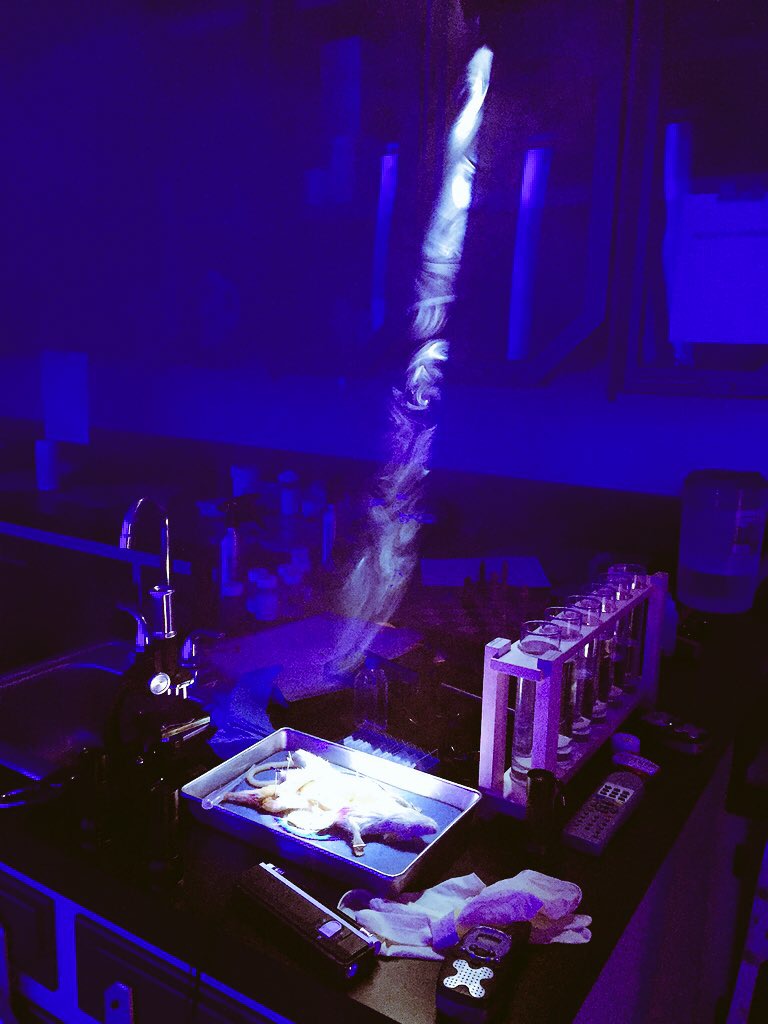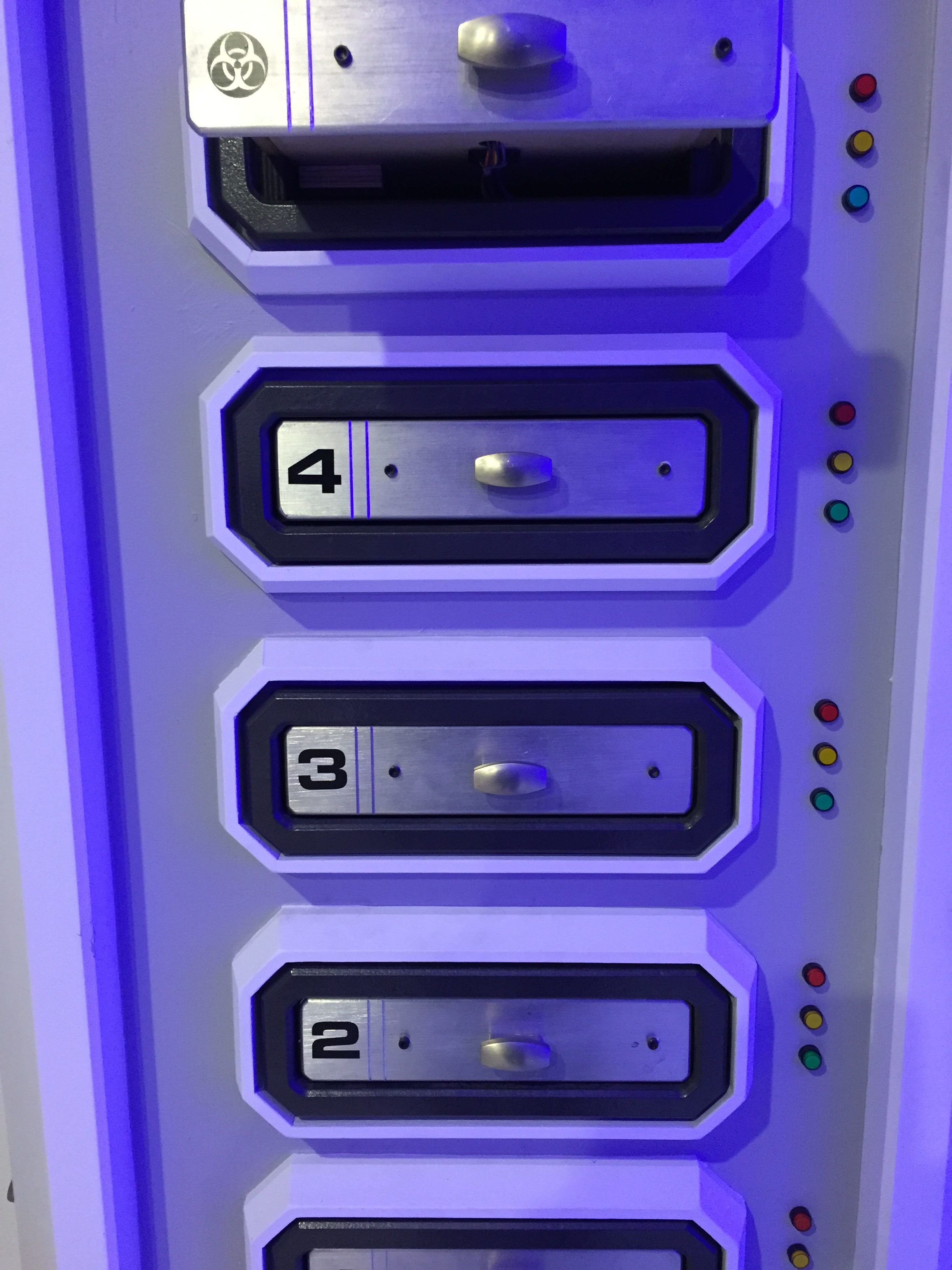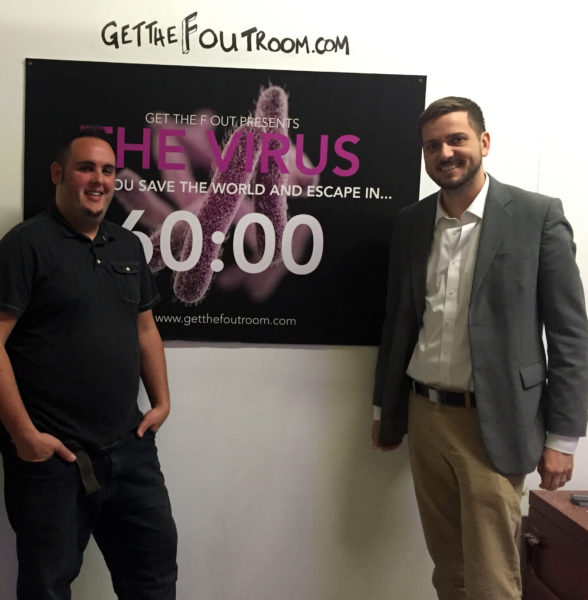RATING: 3 Keys RESULT: Win REMAINING: 5:05
This Virus quickly swept the west coast, but it didn’t infect us.

 A deadly virus sweeps the world and your team must enter an underground lab to find the antidote. The game begins with a briefing from the game master about the worldwide situation before bringing the team into the lab and placing Rift headsets onto every player. Through this VR experience players travel through a system of tunnels and caves and into a final resting place to carry out their scientific work. While traveling, a pre-recorded video message plays out from a scientist giving instructions on why the antidote is hidden behind puzzle layers and the consequences for failing to get the antidote.
A deadly virus sweeps the world and your team must enter an underground lab to find the antidote. The game begins with a briefing from the game master about the worldwide situation before bringing the team into the lab and placing Rift headsets onto every player. Through this VR experience players travel through a system of tunnels and caves and into a final resting place to carry out their scientific work. While traveling, a pre-recorded video message plays out from a scientist giving instructions on why the antidote is hidden behind puzzle layers and the consequences for failing to get the antidote.
A bit of hand waving always occurs in Escape Rooms to justify why players must solve puzzles and open locks, and The Virus does well at lampshading this issue quickly. Although a greater story justification for the steps of the game would be better so as not to have them just be logic puzzles for the sake of puzzles.
The VR component, while an intriguing concept, ultimately does not deliver a compelling experience. This is because of a number of factors. The entire experience is a moving journey, but there’s not any sensation of motion or vibration to sell this effect. Instead, players are left feeling they are just watching a video, albeit a 360° one. The process of putting on the headset and headphones also does not add to the immersion factor. If these were themed to be a protective helmet or some other type of in-world device it would make more sense. Instead, it has the feeling of, “come over here for the VR pre-show.” The quality of graphics for the experience is also quite low, and there’s a strange mismatch between the environment one sees in the VR experience and the room players are physically standing in.

 The game is set in a well decorated but small lab. By the end of the game the counters are covered in various pieces of lab equipment used throughout the course of solving puzzles. There’s some interesting repurposing of recognizable tools to complete challenges. One issue with the scenic design is the choice to have glass doors on all the cabinets that players unlock during the game. Being able to see what’s inside the locked box diminishes the rush of excitement one usually gets when opening a container.
The game is set in a well decorated but small lab. By the end of the game the counters are covered in various pieces of lab equipment used throughout the course of solving puzzles. There’s some interesting repurposing of recognizable tools to complete challenges. One issue with the scenic design is the choice to have glass doors on all the cabinets that players unlock during the game. Being able to see what’s inside the locked box diminishes the rush of excitement one usually gets when opening a container.
Another missed opportunity is also one of the game’s biggest selling points – the moving walls. We were quite excited about the prospect of this effect and spent time talking about how it might be pulled off. Unfortunately, the wall moves in such a subtle way and at a very slow interval that its motion is a somewhat imperceptible effect. After the game was over the game master had us stay in the room and watch the wall reset to its original position. This was the only time the wall’s motion was impressive since the room grew back by nearly a third its size. Using a more dramatic change in size to the level of this resetting motion would have created a more awe-inspiring moment.

 It’s hard to truly judge the difficulty level of the puzzles in The Virus because our guide was quite proactive with hint giving. Often he would step in far in advance of us getting to the normal point of needing to step back and re-evaluate our path. While this made the game flow feel smooth, I would have preferred if we were able to work through puzzles more on our own and only ask for help if we truly got stuck. It seemed like the majority of puzzles had some form of intervention from the game master to steer us in a direction as opposed to letting us just play the game and ask for hints when we wanted them.
It’s hard to truly judge the difficulty level of the puzzles in The Virus because our guide was quite proactive with hint giving. Often he would step in far in advance of us getting to the normal point of needing to step back and re-evaluate our path. While this made the game flow feel smooth, I would have preferred if we were able to work through puzzles more on our own and only ask for help if we truly got stuck. It seemed like the majority of puzzles had some form of intervention from the game master to steer us in a direction as opposed to letting us just play the game and ask for hints when we wanted them.
I enjoyed a couple of science and tech related puzzles and activities that were new to me or used in a different context than I was used to. However, there were also several puzzles that after completing them only revealed a hint on how to solve a puzzle we had already completed. This type of circular clue/hint system can be a good way to embed hints in games, but when retrieving that clue also involves solving a puzzle that takes time, it feels like a wasted allocation of resources.
We also had an issue with the final puzzle requiring prior knowledge to complete. There was a document provided that could be used to solve the challenge, but it involved parsing through a fairly long list of rules and instructions. If a player didn’t already have somewhat of a working knowledge of the subject it could take a long time to figure out the answer. I was the only one in the group who had an understanding of the subject, but it still elicited the same response in me as when I see a jigsaw or sudoku puzzle in a game. I simply didn’t have a desire to complete this generic puzzle let alone as the finale of a game.

We entered The Virus with high expectations and quickly had them lowered inside the lobby area when we saw the exposed backs of set flats. The disappointing VR pre-show further hurt our impression before the game had even started. The hand-holding throughout the puzzle steps of the game was just another strike that could easily be remedied. It’s frustrating to see simple decisions made that hurt a game. If the flats had been covered with a black curtain, or the VR wasn’t there, or we’d been able to work on the puzzles without unsolicited help, we may have had a different impression of the game. While I personally still found the game fun to play quite a few changes could have made the game great, as opposed to just good.

Show your support for Escape Authority and get social with us:

Venue: Get The F Out
Location: Los Angeles, California
Number of Games: 2
GAME SPECIFIC INFORMATION:
Duration: 60 minutes
Capacity: 8 people
Group Type: Public / You may be paired with strangers.
Cost: This venue has permanently closed.















